Introduction to Aoqun: Understanding the Traditional Chinese Ensemble
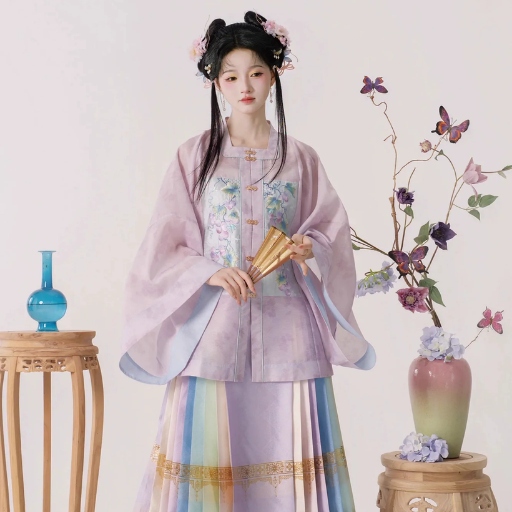
A traditional Chinese two-piece outfit consisting of a shirt (ao) and a skirt (qun), the Aoqun came into being in the early dynasties of China and bloomed with elegance and cultural identity during the Ming Dynasty. The Aoqun was often worn by women from different strata of society and showcased the rich embroidery, vivid colors, and flowing designs popular during that era.
What is Aoqun?
The Aoqun (袄裙) is a particular style of dress under the vast umbrella term Hanfu, representing the ancient clothing of the Han Chinese. This 2-piece garment consists of:
- Long-sleeved blouse (Ao) – The upper garment with a fitted design and intricate embroidery
- Long skirt (Qun) – The flowing lower garment that complements the ao
Hanfu wearers in China (2023)
Industry value (~ USD 1.65B)
Increase in traditional collar searches
Historical Significance of Aoqun in the Ming Dynasty (1368–1644)
The Aoqun held an exalted place in cultural and social roles during the Ming Dynasty. It was worn by women from different social strata in their daily life and on important occasions, signifying their social standing and adherence to Confucianism.
Cultural Symbolism
The Aoqun design aligned with the Confucian value of “ritual and propriety” (Li), with its refined simplicity carrying the moral ideals of the era. Rich colors and carefully chosen embroidered emblems such as dragons, phoenixes, and peonies symbolized prosperity, longevity, and femininity.
Design Features and Components of the Aoqun Hanfu
The Two Essential Components
| Component | Description | Key Features |
|---|---|---|
| Ao (袄) | Customary top garment | Long sleeves, fitted design, intricate patterns or embroidery |
| Qun (裙) | Long skirt complements | Flowing and elegant outline, harmonious design |
Five Distinguishing Features of Aoqun Hanfu
- Fabric Material: Traditionally made from luxurious fabrics such as silk or satin for beauty and smooth texture
- Color Palette: Available in colors from soft pastels to highly saturated shades with cultural significance
- Ornate Embroidery: Fine embroidery with auspicious symbols like flowers, birds, and clouds
- Layered Structure: Designed for layering to impart depth and finesse
- Versatility in Usage: Suitable for daily wear in ancient times and cultural celebrations today
Understanding Collar and Cuff Styles
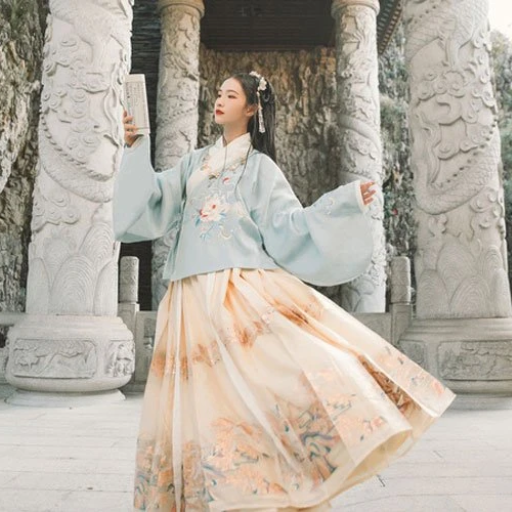
Traditional Cross-Collar Design
The classic Aoqun features a “cross-collar” (Jiaoling) design where the collar wraps diagonally across the body, creating an elegant “Y” shape at the neckline. This design symbolizes modesty and grace in Hanfu culture.
Cuff Characteristics
- Large and flowing design for ease of movement
- Embroidered with fine needlework
- Decorated with auspicious symbols like clouds, cranes, or floral motifs
- Modern adaptations may feature slimmed-down cuffs for daily wear
Modern Interest Statistics
Search results for “traditional Hanfu collar styles” increased by 34% in 2022, while “traditional Hanfu embroidery designs” saw a 40% increase in 2023, indicating growing demand for authentic representations.
Patterns and Embroidery Techniques in Aoqun
Common Traditional Patterns
- Cloud motifs – Symbolizing prosperity
- Peonies – Representing elegance
- Phoenix representations – Signifying good fortune
Traditional Embroidery Techniques
| Technique | Origin | Characteristics |
|---|---|---|
| Suzhou embroidery (苏绣) | Suzhou region | Fine, detailed needlework with silk threads |
| Gu embroidery (顾绣) | Ming Dynasty | Painting-like embroidery technique |
Modern Interpretations and Contemporary Usage
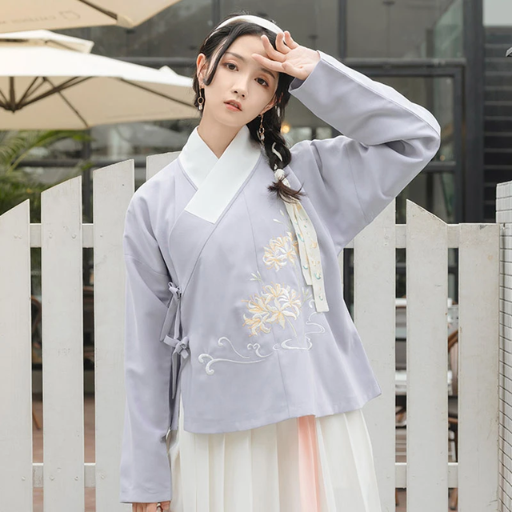
Fashion Evolution
Modern designers are adapting Aoqun with contemporary elements while maintaining cultural authenticity. These adaptations include:
- Integration of Aoqun embroidery into modern jackets and dresses
- Use of sustainable materials and ethical production methods
- Designs appealing to international clientele
- Balance between cultural heritage and modern functionality
Projected ethnic wear market by 2025
Prefer hand-embroidered pieces
Aoqun in Cosplay Culture
The Aoqun has become integral to the cosplay community, particularly among enthusiasts of Chinese historical dramas and fantasy media. The rise of platforms like Instagram and TikTok has showcased elaborate Aoqun designs.
Global Interest Trends
- Surge in “Aoqun cosplay” searches over the past five years
- Interest spanning East Asia, North America, and Europe
- E-commerce platforms offering high-quality Aoqun replicas
- Convention panels and workshops on traditional Asian attire
Creating Your Own Aoqun: A Step-by-Step Guide
Materials Needed
- Fabric of choice (silk, brocade, or cotton) – 4-5 yards
- Matching thread and sewing needles
- Sewing machine (optional)
- Measuring tape, tailor’s chalk, and scissors
- Decorative elements (brocade ribbons, embroidery, trims)
Step-by-Step Process
- Take Accurate Measurements
- Skirt length from natural waistline to desired length
- Waist circumference with extra inches for comfort
- Cut the Fabric
- Rectangular skirt panel (2-3 times waist circumference for fullness)
- Separate waistband piece (3-4 inches wide)
- Sew the Skirt Panels
- Join fabric edges to form a tube or wrap
- Hem the bottom edge with a double roll hem
- Attach the Waistband
- Pleat or gather the top edge evenly
- Sew pleats firmly to the waistband
- Final Fitting and Decorating
- Try on and make adjustments
- Add decorative trims and embroidery
- Final pressing for crisp appearance
Fabric Selection Guide
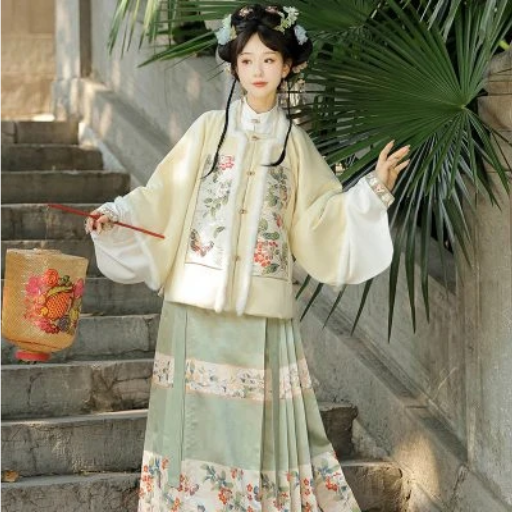
| Fabric Type | Characteristics | Best For | Maintenance |
|---|---|---|---|
| Linen | Lightweight, breathable, elegant drape | Warm climates, casual wear | Easy care, eco-friendly |
| Silk | Lustrous, fluid, luxurious | Formal occasions | High maintenance |
| Cotton | Soft, versatile, beginner-friendly | Everyday wear, first-time sewers | Easy care |
| Synthetic blends | Affordable, durable, modern | Contemporary adaptations | Low maintenance |
Sustainability Consideration
Linen uses approximately 60% less water than cotton production, making it an eco-friendly choice that aligns with modern sustainable fashion trends.
Accessories That Complement the Aoqun
Traditional Accessories
- Jewelry: Jade or pearl pieces for timeless charm and cultural symbolism
- Belts: Statement belts with ornate buckles for a modern edge
- Footwear: Embroidered shoes with floral, bird, or geometric patterns
- Hair accessories: Decorative hairpins and combs with intricate carvings
- Handbags: Embroidered fans and clutches made from high-quality fabrics
Modern Accessory Trends
Recent Google trends data shows an unprecedented boom in searches for “modern Aoqun accessories,” indicating growing interest in blending traditional elements with contemporary style.
Common Challenges and Solutions in Aoqun Crafting
| Challenge | Problem | Solution |
|---|---|---|
| Fabric Handling | Delicate fabrics are difficult to cut/sew | Use sharp scissors, fine needles, stable work surface |
| Fit Checking | Achieving a comfortable, pleasing composition | Detailed measurements, mock-ups for testing |
| Traditional Elements | Balancing tradition with modern needs | Incorporate traditional motifs with minimal modification |
| Color Coordination | Choosing appropriate colors for occasions | Test colors in different lighting conditions |
Cultural Impact: From “The Apothecary Diaries” to Modern Cosplay
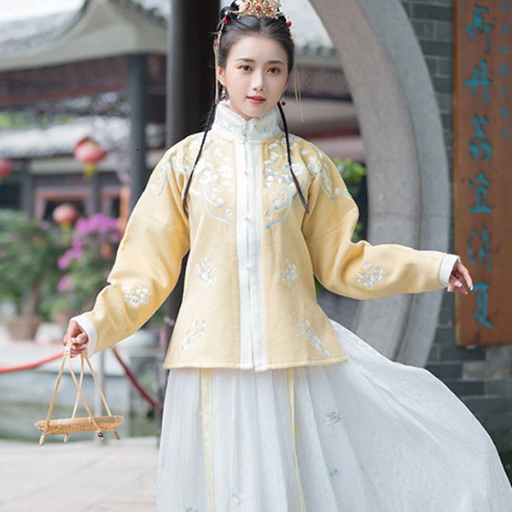
The popular light novel and anime series “The Apothecary Diaries” has significantly influenced modern Aoqun appreciation through its protagonist Maomao’s historically accurate costumes. This cultural phenomenon demonstrates the continuing relevance of traditional Chinese fashion in contemporary media.
Rise in “Apothecary Diaries” cosplay (2023)
Increase in “Maomao cosplay tutorial” searches
Frequently Asked Questions (FAQs)
The Aoqun is a traditional Chinese garment combining an upper garment (ao) and a skirt (qun). It reflects the rich heritage of Chinese clothing, particularly during the Ming Dynasty, and serves as a bridge between historical and modern cultures through the modern Hanfu revival movement.
Focus on details like fabric choice, patterns, and accessories. Select vibrant colors representative of your character, incorporate traditional accessories like embroidered hairpins, and pay attention to sleeve and cuff details that align with the character’s historical period.
The Aoqun consists of a fitted top and separate skirt, while the Ruqun typically features a more flowing, robe-like appearance. Aoqun is often associated with Ming Dynasty fashion, while Ruqun has origins in the Tang and Song dynasties.
Yes! Many tutorials provide step-by-step instructions for creating custom Aoqun, from fabric selection (such as linen) to advanced techniques for pleats and sleeves. Online resources offer free templates and detailed guidance.
The Aoqun represents cultural pride and connection to traditional heritage. Its versatility allows wear for various occasions, while the flattering silhouette and variety of styles (including the popular horse face skirt) appeal to modern sensibilities.
Reference Sources
- University of Michigan: Visions of Chinese Modernity in Vogue
- University of Nebraska-Lincoln: Chinese Textiles as Political Tools in the Nineteenth and Twentieth Centuries
- Connecticut College: Power and Community in Traditional Chinese Dress
Conclusion
The Aoqun represents far more than just traditional clothing—it embodies the artistic sensibilities, cultural values, and historical continuity of Chinese civilization. From its origins in ancient dynasties to its renaissance in modern cosplay and fashion, the Aoqun continues to bridge past and present, offering both cultural connection and artistic expression.
Whether you’re drawn to its historical significance, interested in creating your own piece, or simply admiring its aesthetic beauty, the Aoqun stands as a testament to the enduring power of traditional craftsmanship and cultural identity in our modern world.







